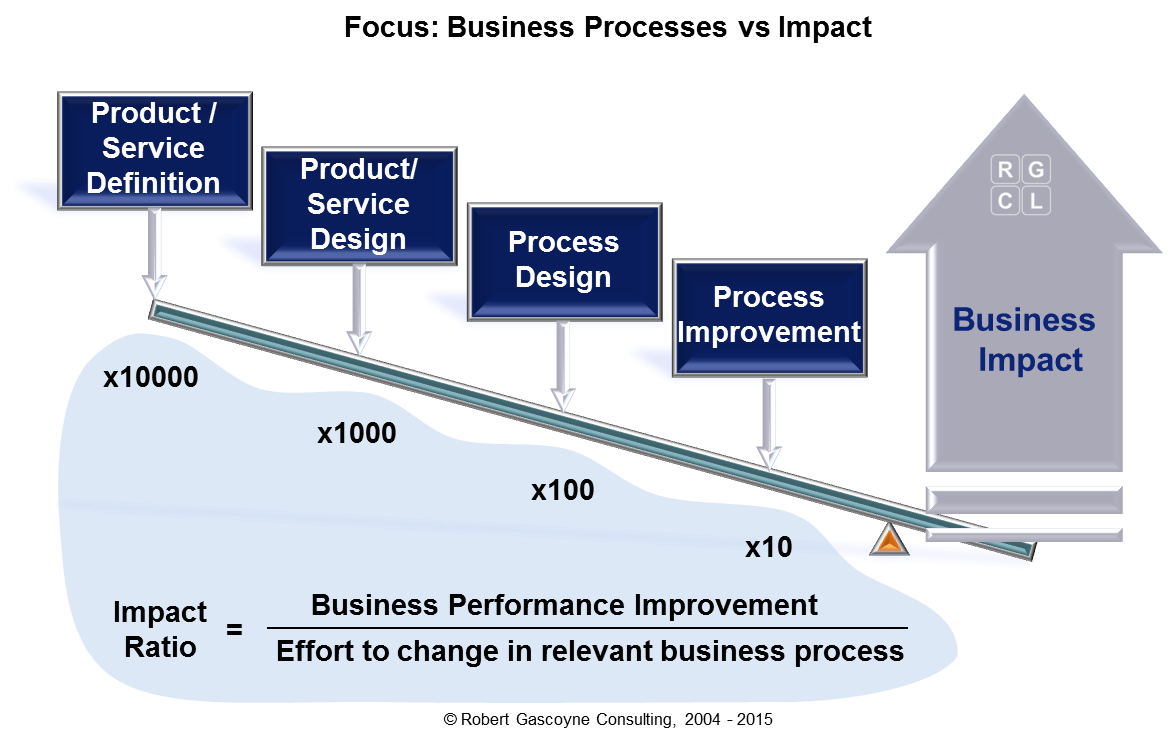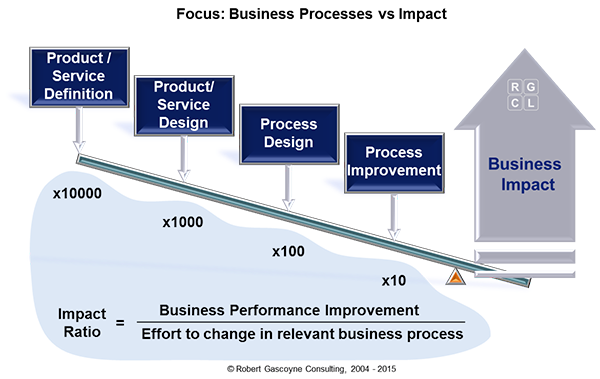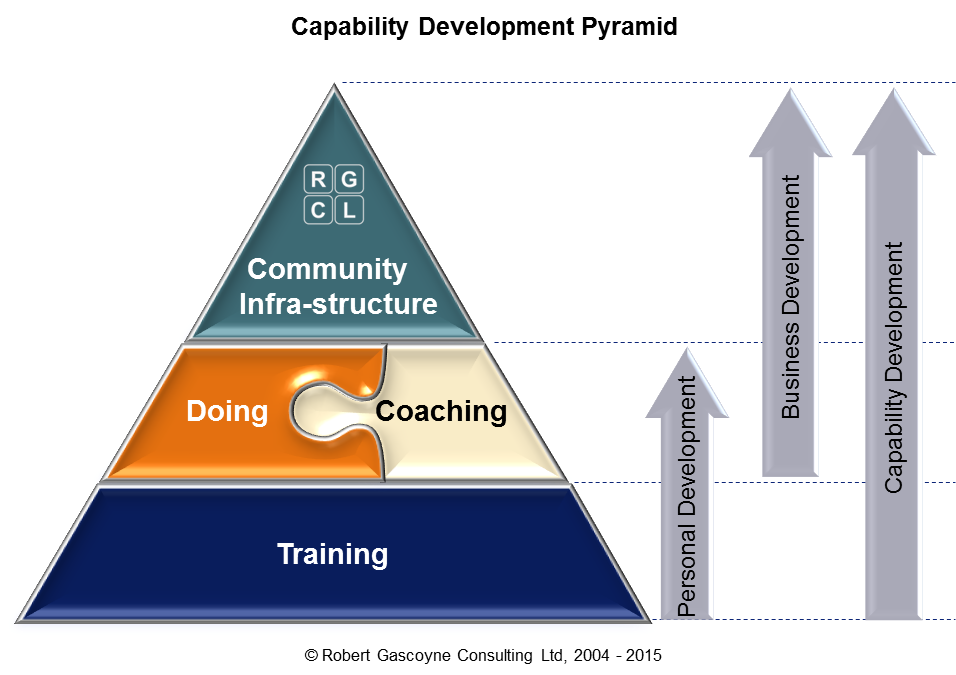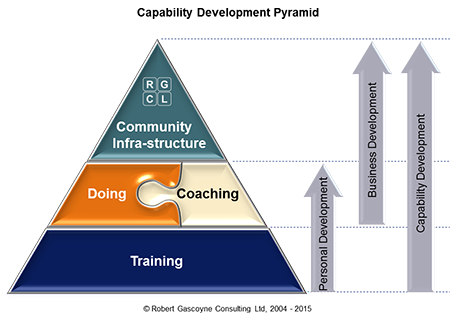Product and service design have an enormous impact on the entire business. However, it is often an area of development that is ‘rushed through’ in an attempt to enter the market quicker.


It is generally considered that focussing on process improvement provides a ten-fold payback relative to the effort put in. However, if the processes had been designed perfectly, the benefit would be ten times greater still. The previous stage in the business value chain is Product or Service design, where changes may have radical impact on the processes (nominally, ten times the impact again). Lastly, the definition of the product has the largest potential impact as it governs the design. Impacting these early phases provides more than performance improvement, it drives business transformation. Our Design services start from definition and go all the way through to launch to ensure an efficient and effective end to end business process.
New Product / Service / Process Development (NPD)
The review confirmed many things we knew [about our NPD process], but more importantly, it showed us many things we didn’t know
We can analyse your NPD processes and management systems to identify weaknesses and corresponding upgrades, using a variety of diagnostic page options, such as Business Analysis, Product Reviews, Service Reviews, Process Reviews, Management System Reviews: and Supplier Diagnostic Visits (SDVs)
A wide variety of tools and techniques is available (see list below). We have substantial experience analysing, training, coaching and facilitating, NPD projects and all of the constituent tools and techniques.
Please contact us to discuss your requirements
Key Tools and Techniques
There are many tools and techniques that can be used as part of a end to end design process, each performing different functions. However, the following deserve a special mention and are offered as part of and end to end service, or individually:
- Product Cost Reduction techniques can be used to reduce unnecessary cost from existing products or services. The design of both the products and the processes that deliver them are critically reviewed with your experts to identify opportunities for cost reduction [more…]
- FMEA or 'Failure Mode & Effects Analysis' is an extremely powerful quality tool that prevents defects by considering how things might fail and putting appropriate controls in place to prevent them. Process FMEA is the most commonly used type . However, System (Concept) FMEA and Design FMEA can be even more powerful, as more change is possible at these stages of development, making it possible to avoid many failure modes altogether! [more…]
- Quality Function Deployment (QFD) is a powerful design tool, which prioritises requirements and translates them into specific deliverables at key stages of development, ensuring that what is delivered is ultimately linked to the customers' requirements. QFD contains the four ‘Houses of Quality’ (HOQ). However, many companies only use the first house of quality and other methods in place of houses two to four. We offer a flexible approach to suit your needs [more…]
- Complexity is an area that is often talked about, but rarely acted upon. Why? - Often because of a lack of knowledge of its negative impact, it’s sometimes confused with variety (the positive variations required by customers) and also because people aren’t sure what they can do about it [more…]
- Variety is about customer choice, but how do you give the customer’s choice and reduce manufacturing variation at the same time? This is a major issue faced by most organisations designing their products and services, with potentially far reaching implications for the customer’s, the product design, the manufacture and supply chain. The solution is to understand the real customer requirements and satisfy these with an agile design, suitable for ‘Mass Customisation’ (also known as ‘Late Point Differentiation’ and ‘Late Configuration’) We have substantial experience training, coaching, consulting and delivering Variety Management solutions, please contact us to discuss your requirements
- Design for Manufacture (DFM) is about designing products that are easy to make. This isn’t a difficult concept, but typically involves new ways of thinking and working. We have substantial experience training, coaching, consulting and delivering DFM solutions, please contact us to discuss your requirements
- Design for Assembly (DFA) is about designing products that are easy to assemble. This isn’t a difficult concept, but typically involves new ways of thinking and working. We have substantial experience training, coaching, consulting and delivering DFA solutions, please contact us to discuss your requirements
- Value Engineering / Value Analysis (VA/VE) is about understanding the perceived value of different aspects of the product or service relative to the actual cost of each of those aspects. The differences between perceived value and engineered cost provide focus to reduce unnecessary cost, or increase value. We have substantial experience training, coaching, consulting and delivering VA/VE, please contact us to discuss your requirements
- Design for Six Sigma (DFSS): is a powerful, effective, ‘heavy-weight’ methodology that is applied to the design of new products, services, and processes. It covers the entire design and development journey from market to launch, ensuring excellence. We offer wide range of strategic and consultancy, training and coaching services in DFSS, tailored to meet your business’ needs [more…]
Why we get results
- We have enormous experience analysing, training, coaching and facilitating all aspects of product, service and process design
- We’re practical and pragmatic - our focus is always on getting results (we’re practitioners - not just trainers!)
- We tailor our services and approach to meet your needs
- Please contact us to discuss your requirements
Capability Development
The level of capability development is an important factor in Strategic and ‘Total Immersion’ deployments


- Training provides knowledge, but real understanding is only developed by doing
- We offer a range of coaching services, to guide capability development and ensure that results are achieved
- Beyond having people that can do, you’ll need your own, sustainable, support structure to ensure the continued growth and success of your capability - we’ll help you create, or develop, your infra-structure to achieve this
Please contact us to discuss your requirements
Next Steps
We'd be glad to provide more details, or discuss your requirements with you. Please contact us
Related Tools, Techniques & Methodologies
We offer consultancy (diagnostics, project definition, projects, deployments, training and coaching in the following design related tools, techniques and methodologies:
Basic Quality Tools
- Pareto Analysis
- Cause & Effect Diagrams (Fishbone, Ishikawa)
- Concentration Diagrams (Measles chart)
- Check Sheets
Mapping Tools
- Spaghetti Diagrams
- Process Chart
- Flowcharting
- Process Maps
- Spaghetti Diagrams
- SIPOC
- Function Trees
- IDEF0
Further Quality Tools
- FMEA Overview
- Concept / System FMEA
- Design FMEA
- Process FMEA
- QFD (Basic, 4 Houses of Quality)
- Complexity (OFD)
- Design For Assembly
- Design For Manufacture
- Mistake/Error Proofing (Poka Yoke)
- CoPQ (Cost of Poor Quality)
- Taguchi Robust Design (system, parameter, tolerance)
- Tolerancing strategies
Graphical Data Analysis
- Histograms
- Boxplots
- Run charts (Time series plots)
- Scatter diagrams
- Multi-Vari Charts
- Interaction charts
Organisational Tools & Prioritisation
- Affinity Diagrams
- Pugh Matrix
Process / Design Control
- Standard Operating Procedures (SOP)
- Out of Control Action Plans (OCAP)
- Gauge control plans
- Control Plans & planning
- Design Validation plans
Basic Statistical Tools
- Basic Statistics
- Introduction to Statistical Process Control (SPC)
- Statistical Process Control (run, X & R, X & s, np, p, c, u charts, etc)
- Process Capability (Cp, CpL, CpU, CpK, Zst, Zlt, PPM)
- Correlation
- Regression - Simple Linear
- Data Types
- Data Collection / Sampling Techniques
Further Statistical Tools
- Central Limit Theorem
- Confidence Intervals
- Power and Sample size
- Regression - Non-linear (quadratic, cubic)
- Multiple Regression)
- Gauge R&R (Attribute, Continuous, Destructive)
- Process Capability - Non-normal (Binomial, Poisson, Weibull)
- CUSUM (+V mask)
- EWMA
- Transforming Non-normal Data (Box Cox, Johnson)
- Process Yield Calculation
- Span
- Stable Operations methodology
Hypothesis testing
- Introduction to Hypothesis testing
- General tests for averages (1 sample Z test, 1 sample t-test, 2 sample t-test, paired t – test, t-test - 2 Sample, 1 proportion test, 2 proportion test)
- Tests for spread / dispersion (F-test, Levene’s test, Bartlett’s test)
- ANOVA (1 way, 2 way, Balanced, MANOVA, General Linear Model, General, Nested)
- Chi Square test
- Non-Parametric tests (1 sample Sign, 1 sample Wilcoxon, Kruskal-Wallis, Mann-Whitney, Moods Median test)
- Normality Testing (Andersen-Darling, Ryan-Joiner, Shapiro-Wilk, Komologorov-Smirnov)
Design of Experiments (DoE)
- Introduction to DoE
- 2 Level - Linear DoE (Full, Fractional, Plackett-Burman, Blocking, main effects plots, interaction plots, etc)
- 3 Level - Non-linear DoE (CCD, Box Benkhen, surface and contour plots)
- Taguchi Designs
Reliability
- Sequential Probability Ratio Testing (SPRT)
- MEOST
- Accelerated Life Testing (ALT)
Management
- Management Systems
- Short Interval Control (SIC)
- Project Status Reporting
- Six Sigma Roles (Champion, GB, BB, MBB)
- Project Charter
- Critical Path Analysis
- Gantt Charts
- Network Charts
- PERT Charts
- Time Management
- Mental planning models (GRPI, TSRE, OSCA)
- Building a Financial benefits & results case
- Certification Requirements
- Design Scorecards
Tactical skills
- Change Management
- Conflict Management
- Effective Meetings
- Faces of resistance
- Facilitation
- Stakeholder analysis
- Leadership
- Team building
Creative Tools
- Brainstorming
- TRIZ
Customer Focus
- VoC
- VoB
- Identifying Customer Needs (Focus Groups, Surveys, Affinity Diagrams, etc)
- CTQ Flowdown
- Kano Model
- Taguchi Loss Function
Data Analysis
- Data Manipulation (basic, intermediate, advanced)
- Minitab™ (basic, intermediate, advanced)
- JMP™ (basic, intermediate, advanced, bespoke)
More Tools
- Too many to list! - Contact us
Please contact us to discuss your requirements
Minitab is a trademark of Minitab Inc.
JMP is a trademark of SAS Institute